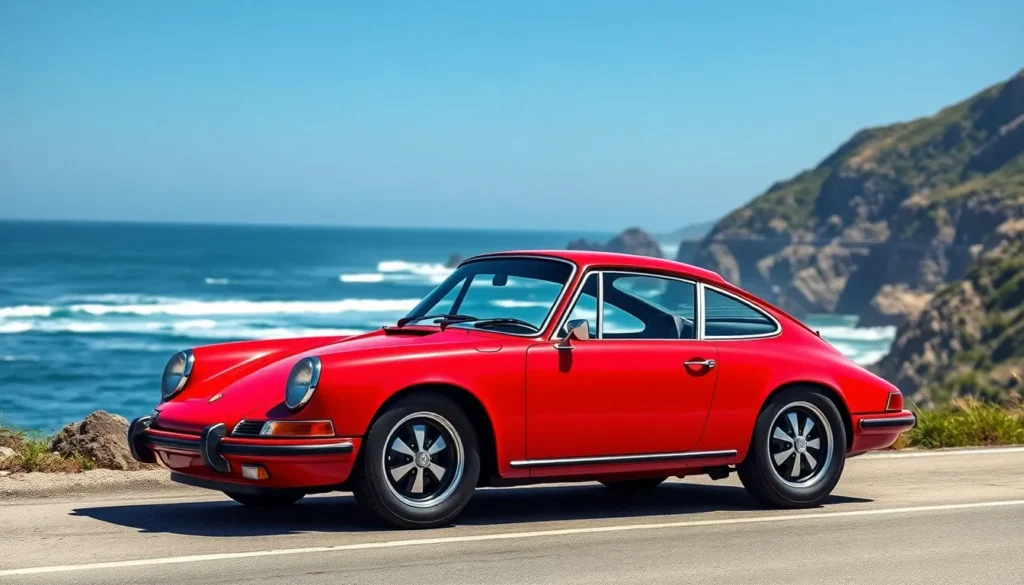We’ve all felt that magnetic pull when a classic Porsche rolls by—there’s something absolutely captivating about the vintage aesthetic that modern cars simply can’t replicate. The sleek curves of a 1960s 911 or the raw elegance of a 356 Speedster represent more than just automotive design; they embody a timeless philosophy where form meets function in perfect harmony.
Today’s car enthusiasts are rediscovering what makes vintage Porsche design so irresistible. From the iconic silhouette that’s remained virtually unchanged for decades to the meticulous attention to detail in every chrome accent and leather stitch, these machines represent automotive artistry at its finest.
Whether you’re a longtime collector or simply appreciate exceptional design, understanding the vintage Porsche aesthetic opens up a industry where engineering excellence meets visual poetry—and we’re here to explore every captivating detail.
What Defines the Vintage Porsche Aesthetic
The vintage Porsche aesthetic emerges from distinctive design principles that prioritize functional beauty over ornamental excess. These timeless elements create an unmistakable visual language that collectors and enthusiasts instantly recognize across decades of automotive evolution.
Classic Design Elements That Endure
Curved body lines form the foundation of vintage Porsche design language, with the 911’s sloping roofline and rounded fenders creating an aerodynamic silhouette that’s remained largely unchanged since 1963. The rear-engine configuration produces a distinctive weight distribution that influences every curve and contour of these classic vehicles.
Chrome accents punctuate key areas like door handles, bumpers, and wheel trim rings, providing contrast against painted surfaces while serving functional purposes. Chrome window surrounds on models like the 356 and early 911s create visual breaks that emphasize the car’s proportions without overwhelming the overall design.
Minimalist interiors showcase German engineering philosophy through clean dashboard layouts, simple gauge clusters, and premium materials like leather and brushed aluminum. The cockpit design prioritizes driver engagement with essential controls positioned within easy reach.
Round headlights became a signature element across vintage Porsche models, with the 911’s distinctive circular housings creating an instantly recognizable face that modern iterations continue to reference. These lighting elements integrate seamlessly into the front fender curves while maintaining optimal visibility.
Iconic Color Palettes and Finishes
Guards Red stands as the most recognizable vintage Porsche color, introduced in 1963 and becoming synonymous with the brand’s racing heritage and performance identity. This vibrant shade appears on countless classic 911s and creates dramatic visual impact against chrome trim and black interior elements.
Signal Orange emerged during the late 1960s as an bold expression of the era’s automotive design trends, with models like the 914 showcasing this distinctive hue that captures attention while maintaining sophisticated appeal. The color choice reflects Porsche’s willingness to embrace contemporary styling while preserving classic proportions.
Ivory and cream tones provide elegant alternatives to traditional white, offering warmth and sophistication that complements vintage Porsche design philosophy. These neutral shades highlight body contours and chrome details while creating timeless appeal that transcends automotive fashion cycles.
Metallic finishes like Silver Metallic and Gold Metallic add depth and richness to vintage Porsche surfaces, with these paint formulations creating subtle color shifts that enhance the cars’ sculptural qualities under different lighting conditions.
| Color Category | Popular Vintage Options | Models Featured |
|---|---|---|
| Bold Primary | Guards Red, Signal Orange | 911, 914, 356 |
| Elegant Neutrals | Ivory, Cream White, Silver | 356 Speedster, 912 |
| Racing Heritage | White, Black, Blue | 906, 907, 908 |
| Metallic Options | Gold Metallic, Bronze | 911 Targa, 914-6 |
Evolution of Porsche’s Timeless Design Language
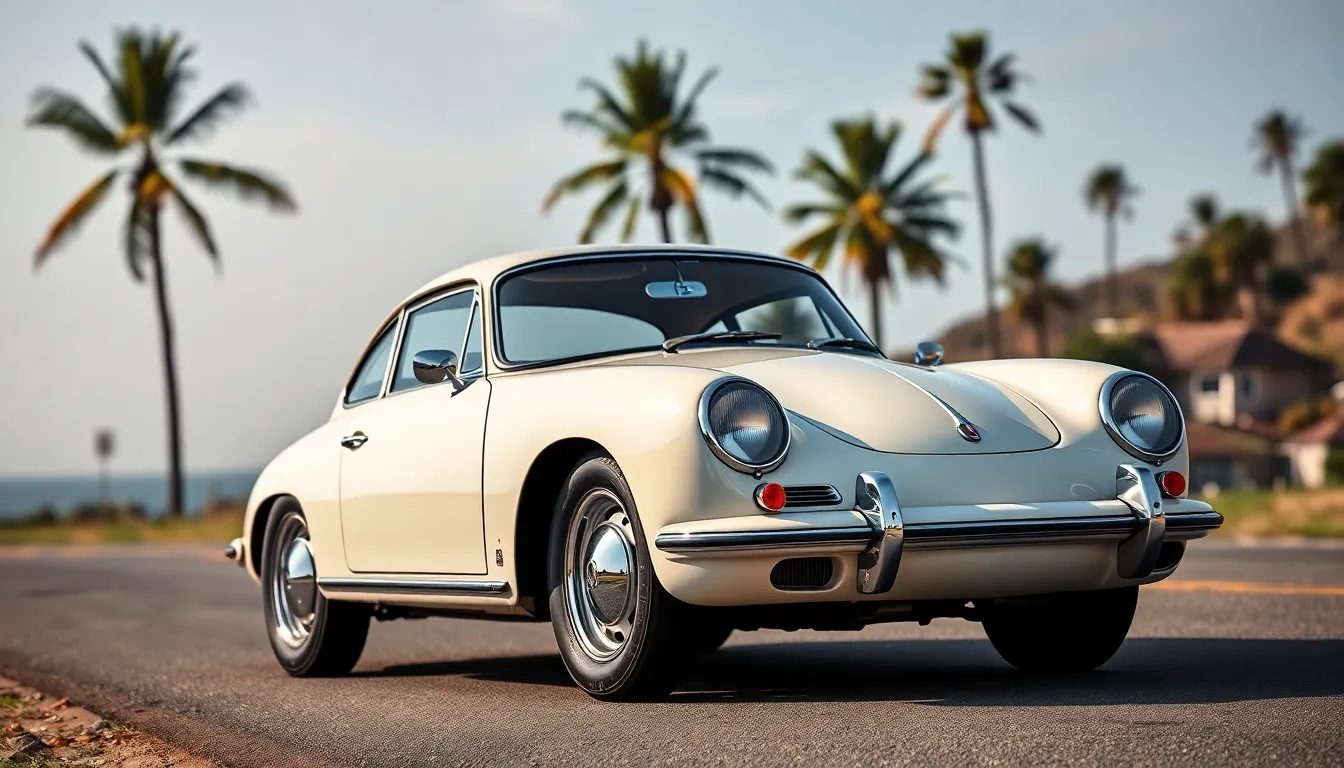
Porsche’s design evolution spans decades of careful refinement while maintaining core aesthetic principles. Each era brought distinct characteristics that contributed to the vintage porsche aesthetic we celebrate today.
1950s-1960s: The Foundation Years
Ferry Porsche established the brand’s design DNA during this groundbreaking period with the introduction of the 356 in 1948. The teardrop silhouette became Porsche’s signature element, featuring smooth curves that flowed seamlessly from front to rear. Round headlights emerged as a defining characteristic, creating the friendly yet purposeful face that distinguished Porsches from angular competitors.
Chrome bumpers dominated the exterior styling during the 1950s, serving both protective and decorative functions. Minimalist interiors focused on essential controls, with simple gauge clusters and leather upholstery that emphasized functionality over luxury. The 356 Speedster introduced in 1954 perfected this approach with its stripped-down aesthetic and low-cut windscreen.
Racing heritage influenced every design decision during the foundation years. Engineers prioritized aerodynamic efficiency, creating forms that naturally reduced drag while maintaining visual appeal. The rear-engine configuration became central to Porsche’s identity, producing the distinctive weight distribution that shaped the car’s proportions.
| Model Year | Key Design Elements | Notable Features |
|---|---|---|
| 1948-1955 | Split windscreen, external door handles | 356 prototype styling |
| 1955-1959 | Integrated bumpers, refined curves | 356A improvements |
| 1960-1963 | Raised headlights, larger windows | 356B updates |
| 1964-1965 | Disc wheels, modernized interior | 356C final evolution |
1970s-1980s: Refinement and Innovation
Butzi Porsche revolutionized the vintage porsche aesthetic with the 911’s introduction in 1963, but the 1970s brought important refinements. Impact bumpers replaced chrome units in 1974, maintaining the car’s proportions while meeting new safety regulations. The distinctive “whale tail” spoiler appeared on the 930 Turbo in 1975, adding both performance function and visual drama.
Interior design evolved toward greater sophistication during this era. Five-gauge instrument clusters became standard across models, creating the cockpit layout that defined the driving experience. Corduroy and tweed seat inserts offered texture variations while maintaining the minimalist philosophy established in earlier decades.
Color palettes expanded beyond traditional choices during the 1970s and 1980s. Metallic finishes gained popularity, with colors like Bronze Metallic and Diamond Silver adding depth to body surfaces. Special edition models introduced unique combinations, including the 1974 914-6’s Creamsicle orange and the 1989 930’s Slantnose package distinctive styling.
Technical innovations influenced aesthetic choices throughout these decades. Integrated fog lights appeared in front bumpers, maintaining clean lines while improving functionality. Wider fender flares accommodated larger wheels and tires, creating the muscular stance that became synonymous with turbocharged models. These elements established design themes that continue influencing vintage porsche aesthetic appreciation today.
Iconic Vintage Porsche Models and Their Aesthetic Impact
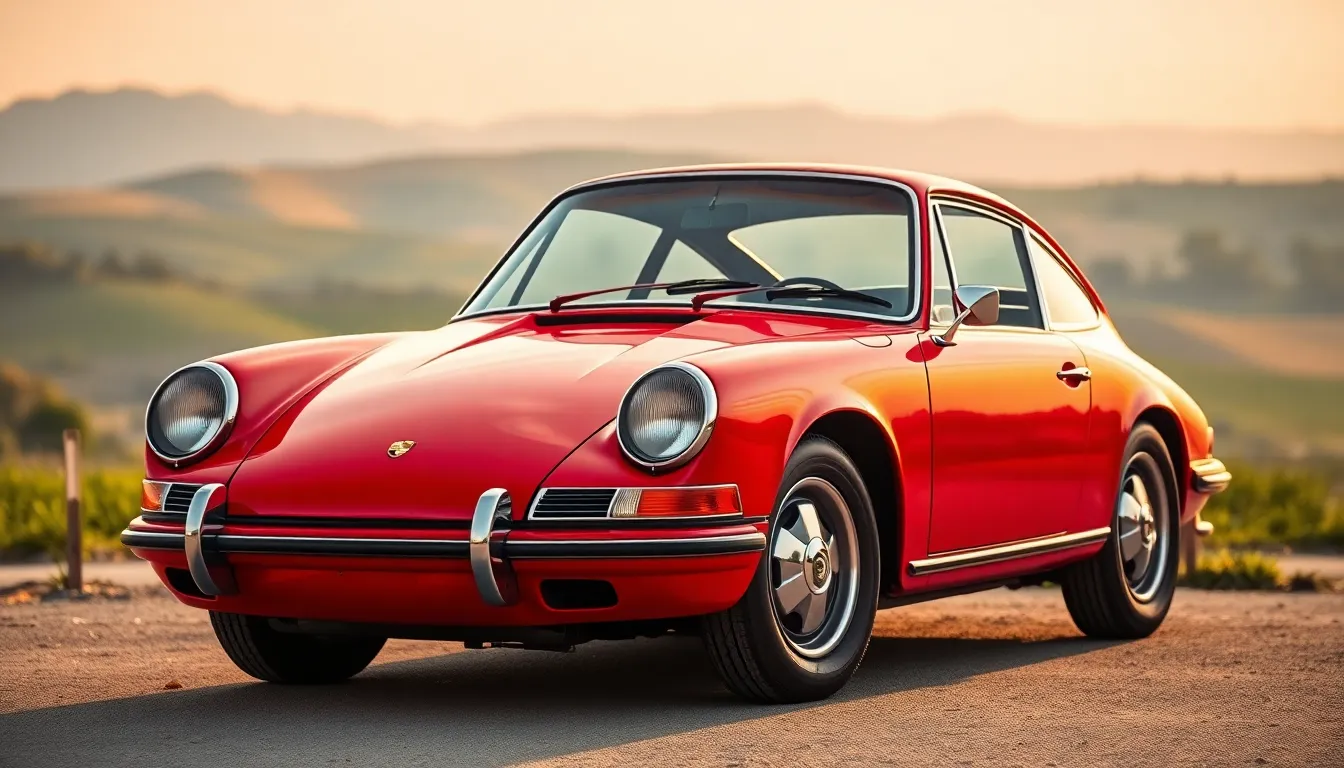
Three legendary models established the vintage Porsche aesthetic we admire today. Each represents a distinct chapter in the brand’s design evolution while contributing essential elements to the timeless visual language.
The 356: Where It All Began
The 356 launched Porsche’s aesthetic journey in 1948 with its revolutionary teardrop silhouette. Ferdinand Porsche’s first production car featured smooth curves that flowed seamlessly from front to rear, creating an aerodynamic profile that became the foundation for all future designs.
Chrome details adorned the 356’s exterior with elegant restraint, appearing on bumpers, door handles, and window trim without overwhelming the clean body lines. Minimalist interiors showcased German engineering principles through simple gauge clusters, leather upholstery, and functional controls positioned for optimal driver interaction.
Round headlights emerged as the 356’s most iconic feature, establishing a design signature that continues across vintage Porsche models. The rear engine placement created distinctive proportions with a sloping nose and pronounced rear haunches, defining the classic Porsche silhouette that collectors recognize instantly.
Color options for the 356 emphasized sophisticated restraint, with ivory, silver metallic, and black dominating early production years. Special editions introduced Guards Red and Signal Orange, linking the aesthetic directly to Porsche’s racing heritage and creating visual connections between street cars and competition vehicles.
The 911: The Ultimate Design Icon
The 911 perfected the vintage Porsche aesthetic when it debuted in 1964, refining the 356’s concepts into automotive artistry. Butzi Porsche’s design created longer proportions while maintaining the essential teardrop shape, resulting in a more muscular yet elegant appearance.
Chrome bumpers on early 911 models provided both protection and visual enhancement, wrapping around the car’s curves with precision engineering. Interior layouts expanded the minimalist philosophy with five round gauges creating the iconic dashboard configuration, while high quality materials like leather and brushed metal reinforced the premium aesthetic.
The 911’s rear spoiler evolution showcased functional beauty as aerodynamic requirements shaped visual elements. Early models featured subtle integrated spoilers, while later versions introduced the dramatic “whale tail” design that became synonymous with 1970s Porsche aesthetics.
| Model Year Range | Key Aesthetic Features | Signature Colors |
|---|---|---|
| 1965-1973 | Chrome bumpers, narrow body, classic proportions | Guards Red, Signal Orange, Light Ivory |
| 1974-1977 | Impact bumpers, flared fenders, wider stance | Metallic Silver, Oak Green, Grand Prix White |
| 1978-1989 | Whale tail spoiler, refined details, enhanced aerodynamics | Guards Red, Black, Silver Metallic |
Racing heritage influenced every 911 design element, from the functional air intakes to the distinctive rear engine cooling vents. Competition models introduced wider fender flares and aggressive spoilers that later appeared on street versions, creating visual connections between track and road cars.
The 914 and 928: Experimental Elegance
The 914 challenged vintage Porsche conventions with its mid engine layout and angular design language starting in 1970. Pininfarina’s influence created clean geometric lines that departed from traditional curves while maintaining aerodynamic efficiency and functional beauty.
Removable targa top sections on the 914 provided open air driving experiences without compromising structural integrity. Black safety roll bars became signature aesthetic elements, creating visual contrast against bright exterior colors like Saturn Yellow and Phoenix Red.
Interior design emphasized driver focused layouts with simplified controls and sporty bucket seats. Dashboard configurations featured horizontal gauge arrangements that differed from traditional 911 circular patterns while maintaining German engineering principles of clarity and functionality.
The 928 represented Porsche’s grand touring vision with sophisticated luxury aesthetics beginning in 1978. Smooth body surfaces integrated advanced aerodynamics with elegant proportions, creating a front engine design that maintained Porsche’s distinctive character through careful detail work.
Pop up headlights became the 928’s most recognizable feature, providing aerodynamic benefits while closed and distinctive lighting when extended. Interior appointments reached new levels of luxury with leather surfaces, electronic controls, and climate systems that elevated the vintage Porsche aesthetic into premium territory.
Both models expanded color palette options beyond traditional choices, introducing metallic finishes and unique combinations that influenced later Porsche aesthetics. Experimental approaches in these models provided design elements that appeared in future generations while establishing their own distinct visual identities within the vintage Porsche family.
Interior Design Philosophy of Classic Porsches
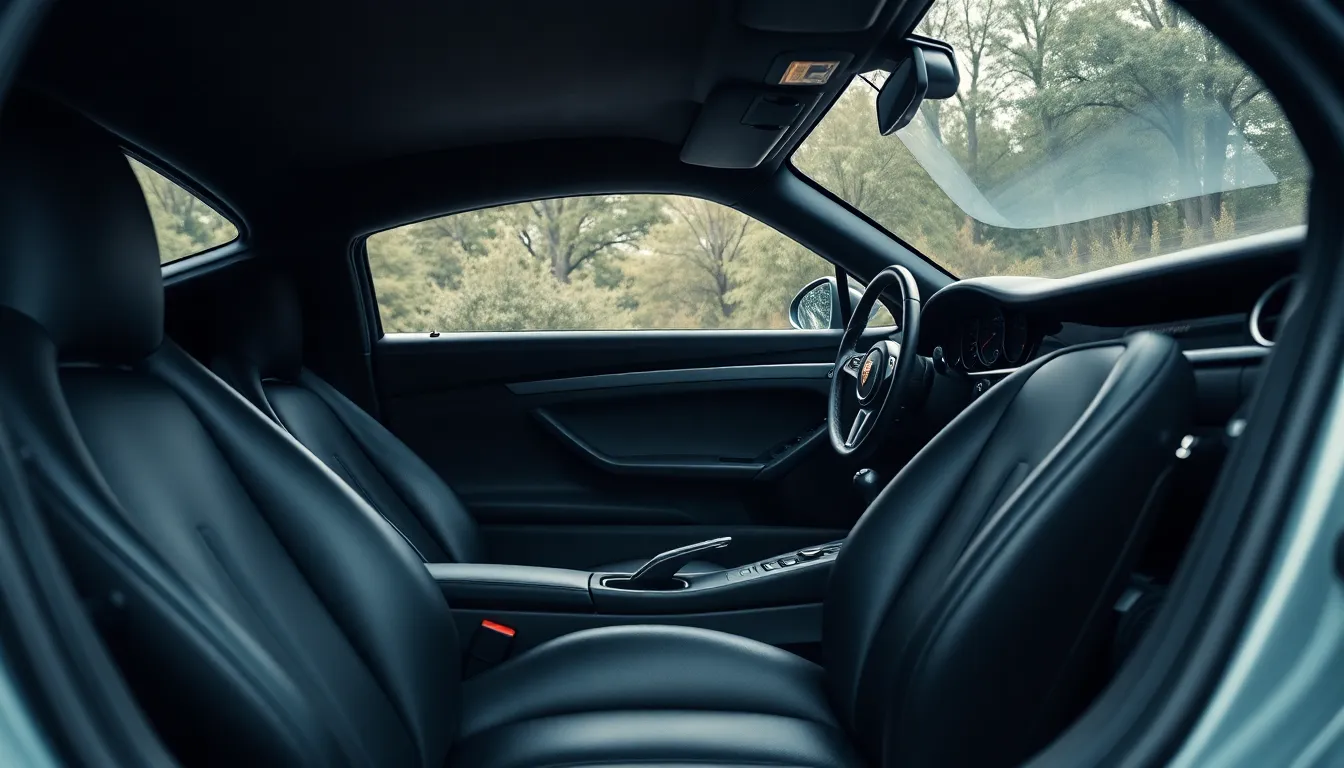
Classic Porsche interiors embody a design philosophy centered on purposeful elegance and driver-focused functionality. This approach creates cockpits that serve the driving experience while maintaining the sophisticated aesthetic that defines vintage Porsche appeal.
Minimalist Functionality Meets Luxury
Minimalist design principles guide every element of vintage Porsche interiors, creating spaces where luxury emerges through restraint rather than excess. Dashboard layouts feature clean lines with essential controls positioned for intuitive driver access, eliminating unnecessary decorative elements that could distract from the driving experience.
Seat designs prioritize ergonomic comfort with subtle luxury touches like hand-stitched seams and premium leather surfaces. Control surfaces follow German engineering principles, placing critical functions like ignition switches and gear selectors within natural reach patterns.
Interior color schemes typically feature two or three complementary tones, avoiding complex patterns that compete with the car’s mechanical precision. Black leather interiors with chrome accents represent the most classic combination, while cork brown and tan options provide warmer alternatives that maintain the minimalist aesthetic.
Gauge clusters demonstrate this functional luxury approach through their circular instruments with clear white faces and precise black numerals. Tachometers occupy the central position in 911 models, emphasizing the car’s performance focus while maintaining visual elegance.
Materials and Craftsmanship Details
Premium materials define vintage Porsche interiors through carefully selected components that age gracefully and maintain their tactile appeal across decades. Leather upholstery uses full-grain hides sourced from German tanneries, creating surfaces that develop character through use while retaining structural integrity.
Metal components feature brushed aluminum finishes on dashboard trim pieces and door handles, providing subtle contrast against darker interior tones. Chrome details appear sparingly on key elements like window cranks, mirror housings, and gear shift knobs, adding precision highlights without overwhelming the space.
Carpet materials consist of dense wool blends that resist wear patterns and maintain their deep pile texture through regular use. Door panel construction combines leather-wrapped surfaces with perforated sections that provide both visual interest and practical ventilation.
Steering wheel craftsmanship represents the pinnacle of vintage Porsche interior quality, featuring hand-wrapped leather over solid metal frameworks. Three-spoke designs with thin rim profiles enhance driver connection while chrome horn rings add distinctive visual appeal.
| Interior Material | Classic Models | Quality Features |
|---|---|---|
| Full-grain leather | 911, 356, 928 | Natural aging, premium texture |
| Brushed aluminum | 911 Turbo, 928 | Corrosion resistance, precise finish |
| Wool carpet | All vintage models | Durability, color retention |
| Chrome accents | 356, early 911s | Hand-polished, long-lasting shine |
How Vintage Porsche Aesthetic Influences Modern Design
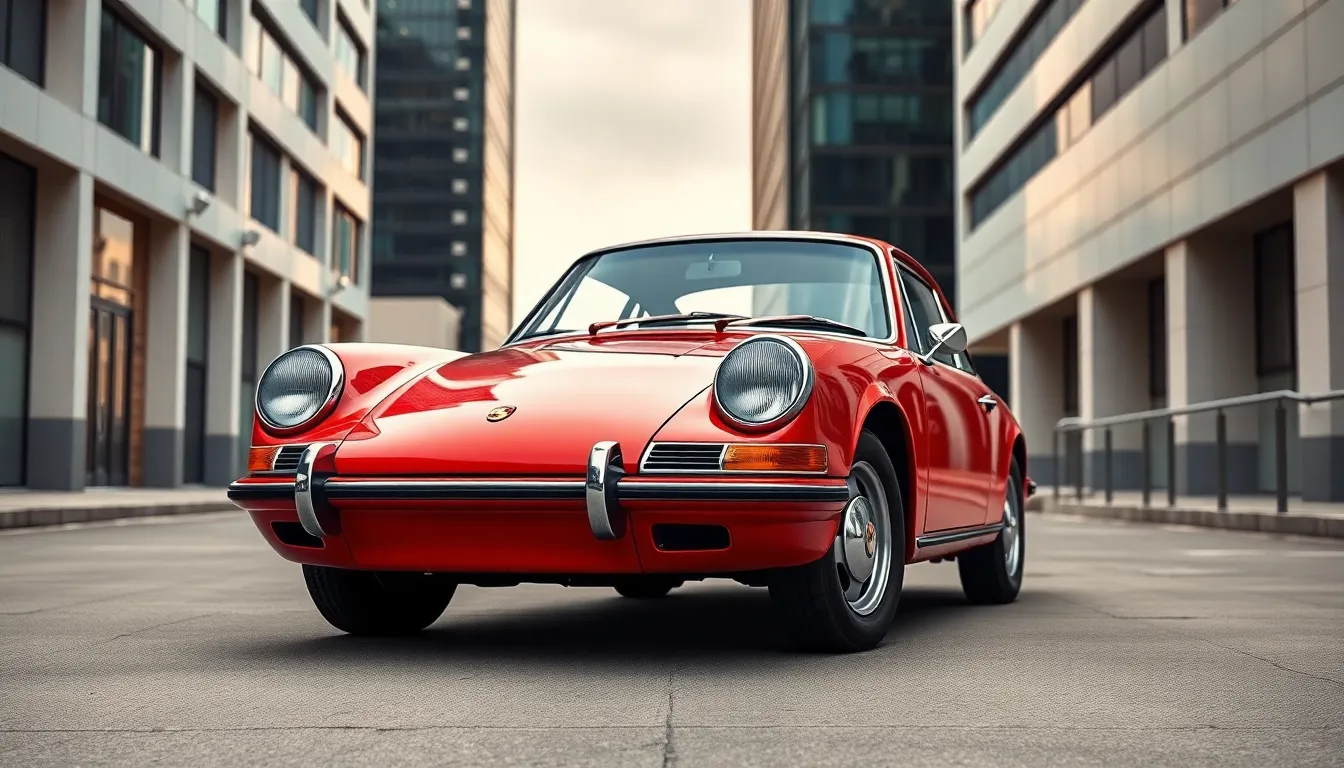
Vintage Porsche design principles continue to shape contemporary automotive and lifestyle products across multiple industries. Modern designers draw inspiration from the timeless elements that defined classic Porsche models from the 1950s through 1980s.
Contemporary Porsche Models
Contemporary Porsche vehicles maintain the fundamental design DNA established by their vintage predecessors while incorporating modern technology and safety requirements. The current 911 Carrera preserves the iconic rear-engine silhouette and round headlights that originated with the 356 in 1948, demonstrating how classic proportions translate into modern manufacturing.
Today’s Porsche lineup features design elements that directly reference vintage aesthetics through subtle interpretations. The Taycan electric vehicle incorporates the teardrop profile and minimalist interior philosophy of classic models, proving that vintage design principles work effectively with cutting-edge electric powertrains. Modern Porsche interiors maintain the driver-focused cockpit layout and premium material selection that characterized vintage models, using contemporary versions of leather, aluminum and carbon fiber.
Color options in current Porsche models frequently celebrate vintage palettes through heritage paint programs. Guards Red remains available across the entire lineup, while special editions often feature Signal Orange, Racing Yellow and other classic hues that originated in the 1960s and 1970s. These vintage-inspired colors generate important demand among collectors and enthusiasts who appreciate the historical connection.
Fashion and Lifestyle Brands
Luxury fashion brands regularly incorporate vintage Porsche aesthetic elements into their product designs, particularly focusing on the clean lines and functional elegance that defined classic models. Designer clothing collections feature color palettes inspired by vintage Porsche paint options, with Guards Red and Signal Orange appearing in everything from leather jackets to luxury sneakers.
Watch manufacturers create timepieces that mirror vintage Porsche dashboard designs, using round faces, minimalist layouts and premium materials like brushed steel and leather. TAG Heuer produces the Carrera collection, which directly references Porsche racing heritage through design elements that echo vintage instrument clusters and steering wheel details.
High-end furniture designers apply vintage Porsche principles to create seating and lighting that reflects the same purposeful elegance found in classic interiors. These products feature clean geometric forms, premium leather upholstery and aluminum accents that capture the sophisticated minimalism of vintage Porsche cabins. Technology companies incorporate vintage Porsche aesthetic elements into consumer electronics, using curved forms and premium materials that reference the timeless design language of classic models.
Home design brands offer vintage Porsche-inspired products including lighting fixtures that echo the round headlight design and furniture pieces that incorporate the curved body lines and color schemes of iconic models from the 1960s and 1970s.
Collecting and Restoring Vintage Porsche Aesthetics

Collecting vintage Porsches extends beyond mere ownership to preserving automotive art history. Restoration enthusiasts face critical decisions that directly impact both aesthetic authenticity and long-term value appreciation.
Maintaining Original Design Integrity
Original design integrity represents the cornerstone of successful vintage Porsche restoration projects. Preserving factory specifications maintains the aesthetic purity that makes these vehicles collectible treasures.
Paint codes from Porsche’s original documentation guide authentic color restoration. Guards Red #027, Racing Yellow #118, and Signal Orange #226 require exact formulations to match period-correct finishes. Metallic paint processes from the 1960s and 1970s used different application techniques that create unique depth characteristics.
Chrome restoration demands specialized knowledge of original plating processes. Bumpers and trim pieces from the 356 and early 911 models used triple-chrome plating that differs from modern techniques. We recommend sourcing chrome work from specialists who understand vintage specifications rather than contemporary automotive shops.
Interior components require careful attention to material authenticity. Houndstooth fabric patterns from 1960s 911 models have exact weave densities that reproduction materials often miss. Leather treatments used synthetic dyes in certain production years while others featured natural tanning processes that age differently.
Engine bay aesthetics matter significantly for concours-level restorations. Weber carburetors on 1960s models feature exact casting marks and finish textures. Porsche’s factory engine paint colors varied by model year, with crinkle-finish valve covers appearing on certain 356 variants but not others.
Documentation preserves restoration authenticity through photographs and receipts. Porsche Certificate of Authenticity confirms original specifications including paint codes, interior materials, and optional equipment. These documents validate restoration choices and support market value assessments.
Market Value and Aesthetic Authenticity
Market values for vintage Porsches directly correlate with aesthetic authenticity and restoration quality. Collectors pay premium prices for vehicles that maintain original design characteristics and period-correct modifications.
Numbers-matching components command the highest market premiums. Original engines, transmissions, and body panels increase values by 25-40% compared to restored examples with replacement parts. Aesthetic modifications that deviate from factory specifications typically reduce market appeal among serious collectors.
Concours-quality restorations achieve the strongest market performance when they preserve original design elements. Barrett-Jackson auction results from 2023 show restored 911s with original paint schemes selling for 15-20% more than examples with non-original color combinations.
| Model Year | Original Aesthetic Features | Market Premium |
|---|---|---|
| 1965 911 | Ivory paint, Houndstooth seats | 30-35% |
| 1957 356A | Signal Red, Beige interior | 25-30% |
| 1973 911 Carrera | Guards Red, Black interior | 20-25% |
| 1967 911S | Polo Red, Pepita fabric | 35-40% |
Modification reversibility affects long-term value retention. Installing aftermarket wheels or modern audio systems reduces authenticity scores at concours events. Collectors prefer modifications that enhance performance without altering visual aesthetics, such as electronic ignition systems hidden within original distributors.
Regional market preferences influence aesthetic value assessments. European collectors favor original European-specification models with yellow headlights and metric speedometers. American collectors often prefer US-specification examples with sealed-beam headlights and MPH gauges.
Professional appraisals consider aesthetic authenticity as a primary valuation factor. Certified appraisers examine paint thickness measurements, interior wear patterns, and component date codes to verify restoration quality. Insurance companies require these assessments for agreed-value policies that protect restoration investments.
Investment potential increases when restoration work maintains museum-quality aesthetic standards. Vintage Porsche values have appreciated 12-15% annually over the past decade, with the most authentic examples leading price appreciation trends.
Conclusion
The vintage Porsche aesthetic represents more than automotive design—it’s a timeless philosophy that continues to shape luxury products and modern vehicles today. We’ve seen how these classic cars established design principles that transcend their era and influence everything from contemporary fashion to high-end furniture.
Whether you’re drawn to the investment potential or simply captivated by their enduring beauty vintage Porsches offer something truly special. Their ability to maintain relevance across generations proves that exceptional design never goes out of style.
For enthusiasts and collectors alike these iconic vehicles represent the perfect marriage of form and function. We believe that understanding and appreciating vintage Porsche aesthetics enriches our connection to automotive history and design excellence.
Frequently Asked Questions
What makes vintage Porsche design so timeless and appealing?
Vintage Porsches combine functional beauty with iconic design elements like curved body lines, round headlights, and teardrop silhouettes. Their minimalist interiors emphasize driver-focused functionality while using premium materials. The perfect blend of form and function, along with distinctive racing heritage influences, creates an aesthetic that has captivated enthusiasts for decades and continues to influence modern design.
Which vintage Porsche models are considered the most iconic?
The most iconic vintage Porsche models include the 356 (1948-1965), which established the teardrop silhouette; the 911 (1963-present), featuring the classic rear-engine configuration; and the 928 (1977-1995), representing grand touring luxury. The 914 also holds significance for its mid-engine design innovation. Each model contributed essential elements to Porsche’s timeless visual language.
What are the signature color schemes of vintage Porsches?
Classic vintage Porsche colors include Guards Red and Signal Orange, reflecting the brand’s racing heritage. Elegant neutrals like Ivory White and Cream provide sophisticated alternatives. Metallic finishes such as Silver Metallic and Bronze add depth to surfaces. These color palettes have become synonymous with vintage Porsche identity and continue influencing modern automotive design choices.
How do vintage Porsche interiors reflect the brand’s design philosophy?
Vintage Porsche interiors embody purposeful elegance through minimalist design principles and driver-focused layouts. They feature premium materials like full-grain leather and brushed aluminum that age gracefully. Clean dashboard designs, ergonomic seats, and functional gauge clusters create luxurious yet restrained environments. This philosophy emphasizes tactile quality and visual elegance over unnecessary ornamentation.
Are vintage Porsches good investment vehicles?
Yes, vintage Porsches have shown strong investment potential with values appreciating significantly over the past decade. Market values correlate directly with aesthetic authenticity and original design integrity. Numbers-matching components command higher premiums. However, modifications can impact long-term value retention, making professional appraisals crucial for verifying restoration quality and investment viability.
How do modern Porsches maintain vintage design DNA?
Contemporary Porsche models preserve fundamental design elements established by vintage predecessors while incorporating modern technology. The current 911 Carrera maintains iconic features like rear-engine silhouette and round headlights. Even the electric Taycan reflects classic design through its teardrop profile and minimalist interior, demonstrating how timeless aesthetic principles adapt to new automotive technologies.
What should collectors consider when restoring vintage Porsches?
Collectors should prioritize maintaining original design integrity, including authentic paint codes, chrome restoration, and period-correct interior materials. Professional expertise is essential for preserving aesthetic authenticity, which directly impacts long-term value appreciation. Restoration decisions should balance personal preferences with market expectations, as authentic restorations typically command higher premiums than modified examples.

